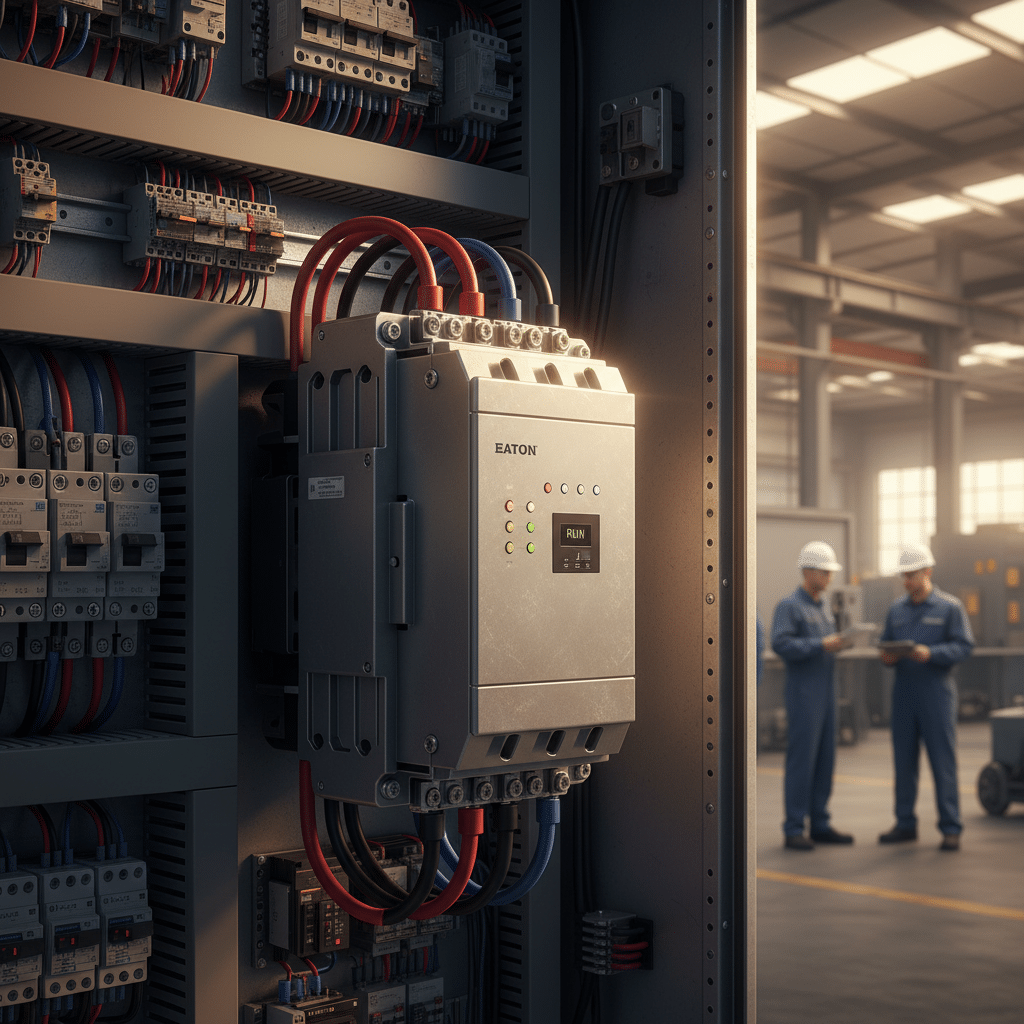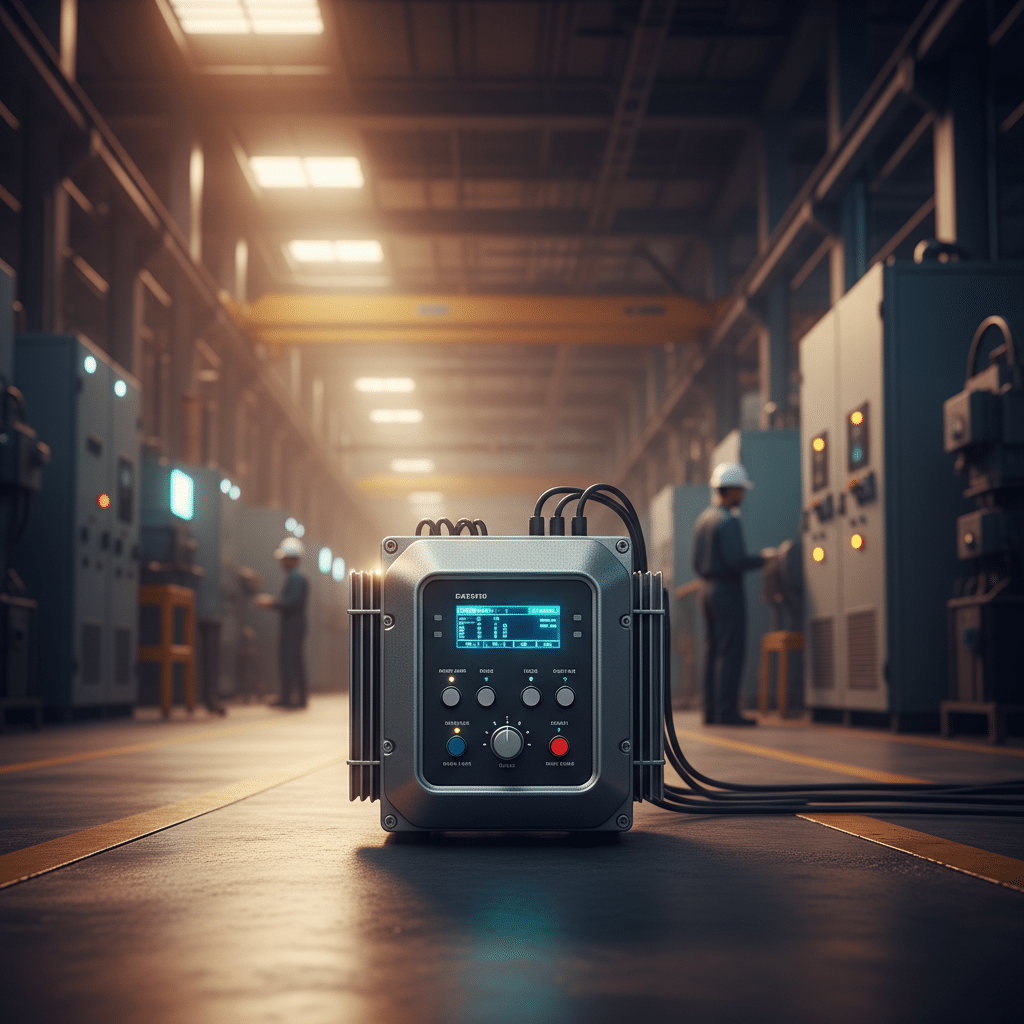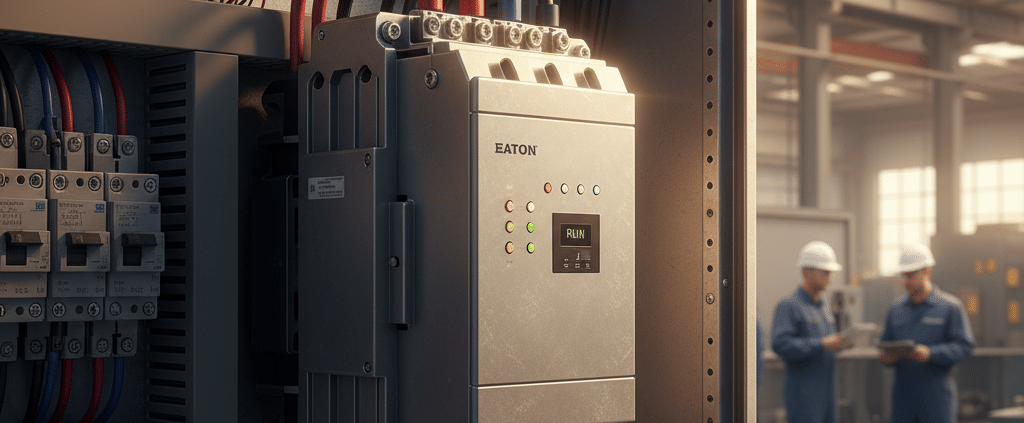Eaton S801+ Softstarters: A Complete Technical Guide
Estimated reading time: 11 minutes
Introduction: the Critical Role of Reduced Voltage Starting for Motor Longevity
Protecting AC induction motors to extend their life requires reduced voltage starting. Modern devices like eaton S801+ softstarters are engineered to mitigate this stress. A direct-on-line (DOL) start creates a massive electrical inrush. This is often 6-8 times the motor’s normal current and strains the power system. The sudden torque also applies a jarring mechanical shock to equipment. As Eaton Soft Starters notes, eliminating abrupt starts reduces wear on critical components.
An Eaton reduced voltage starter works by gradually increasing voltage to the motor. In turn, this controlled ramp-up allows for a smooth acceleration. Consequently, it prevents the electrical and mechanical jolts of a DOL start. This process uses silicon-controlled rectifiers (SCRs) to manage the voltage precisely, as noted by Eaton S801 vs S811 Soft Starters. The inrush current is significantly lowered. This also reduces stress on the electrical supply and minimizes voltage dips that could affect other equipment.
The long-term benefit of this control is a substantial increase in equipment longevity. By mitigating wear and tear, facilities experience fewer unexpected breakdowns. This leads to more predictable maintenance and lower operational costs. For instance, in pumping applications, a soft stopping feature eliminates the damaging water hammer effect. This protects pipes and valves, as highlighted by Eaton. Ultimately, integrating a device like the S801 is a strategic investment in system reliability, which is why it is a top choice for these applications, according to S801+ Soft Starter User Manual.
Why Choose Eaton S801+ Softstarters? Key Features and Specifications
Choosing the right reduced voltage starter is crucial for protecting equipment, and eaton S801+ softstarters stand out as a compact, intelligent, and highly reliable solution. These devices are engineered to provide a smooth, stepless acceleration for three-phase AC induction motors by gradually increasing the applied voltage. Consequently, this controlled start significantly reduces mechanical shock on components like gears and belts and minimizes the electrical stress caused by high inrush currents. For a comprehensive overview, the Eaton S801 datasheet provides detailed specifications.
Furthermore, a key advantage of the S801 series is its extensive set of built-in protective features. According to S801+ Soft Starter User Manual, the device monitors for overload, phase loss, phase reversal, and shorted SCRs, safeguarding the motor from common fault conditions. The inclusion of an integrated bypass contactor simplifies the s801 motor starter setup, which in turn reduces panel space, wiring complexity, and overall installation costs. This integrated design makes it an efficient choice for both new installations and retrofitting existing motor control centers.
From a performance standpoint, the S801 offers precise control over the motor’s starting and stopping characteristics. For instance, users can adjust initial torque from 0 to 85% and set a kick-start time to handle high-inertia loads. A standout feature is the unique soft-stopping control, which smoothly ramps down the voltage to eliminate the water hammer effect in pumping systems, a common issue that can damage pipes and valves as highlighted by Eaton Soft Starters. This level of control, combined with its robust protection and compact form factor as noted by Eaton S801 vs S811, makes the eaton reduced voltage starter a superior choice for extending motor and system longevity.

The Eaton S801 softstarter minimizes electrical and mechanical stress during motor startup, a critical function for extending the operational life of industrial equipment.
Proper Sizing and Selection for Your Application
Selecting the correctly sized model is the most critical step for ensuring the reliable performance and longevity of your Eaton S801+ softstarters. A unit that is too small will be prone to nuisance tripping and premature failure, while an oversized unit is not cost-effective. Consequently, your selection process must begin with a thorough analysis of the AC induction motor’s nameplate data and the specific demands of the connected mechanical load. According to Eaton S811/S801 Soft Starters, proper application extends the life of mechanical components by reducing stress. This foundational step ensures both operational safety and system efficiency from the outset.
Sizing Eaton S801+ Softstarters By Motor FLA
The primary factor for sizing an Eaton reduced voltage starter is the motor’s Full Load Ampere (FLA) rating, not its horsepower. You must choose an S801+ model with a continuous current rating equal to or greater than the motor’s FLA. In addition, consider the application’s duty cycle, including the required number of starts per hour and the nature of the load. For instance, high-inertia loads like large fans or heavy conveyors may require a larger soft starter to handle the extended acceleration time without overheating. As noted by Eaton S801 vs S811, the built-in bypass contactors are key features that help manage thermal load after a successful start.
Finally, environmental conditions play a significant role that cannot be overlooked. The standard ratings for S801 starters are typically based on an operating environment with a specific ambient temperature range and altitude. If the starter will be installed in a location with higher temperatures, such as a hot equipment room, or at a high altitude, you must apply derating factors as specified in the S801+ soft starter datasheet. Always consult the official Eaton S801+ Soft Starter Manual user manual for these critical derating curves. Neglecting these adjustments can lead to inadequate performance and significantly reduce the lifespan of the equipment, as documented in technical specifications.
Step-by-step S801+ Motor Starter Setup and Installation
Proper S801 motor starter setup is fundamental to ensuring the long-term reliability of your AC induction motor. Before beginning any work, it is absolutely critical to adhere to all relevant safety standards, including NFPA 70E, and implement strict Lockout/Tagout (LOTO) procedures to de-energize the circuit completely. First and foremost, consult the official S801+ Soft Starter User Manual user manual for your specific model, as it contains essential wiring diagrams and safety warnings. A successful installation begins with verifying that the selected Eaton S801+ softstarter’s voltage and current ratings match the motor’s nameplate data and application demands.
Mounting & Wiring Eaton S801+ Softstarters
Next, securely mount the Eaton reduced voltage starter in a suitable enclosure that allows for adequate ventilation to dissipate heat, preventing potential overheating issues. The compact design of the S801 series often simplifies this process, allowing for installation in panels where space might be limited. According to Eaton S801 vs S811 Soft Starters, these units are typically open chassis, designed for user-supplied enclosures. Proceed with wiring the line-side power (L1, L2, L3) and motor-side load connections (T1, T2, T3) using appropriately sized conductors per National Electrical Code (NEC) guidelines. Subsequently, connect the control wiring for start/stop commands and any optional monitoring outputs.
Once all physical connections are verified and torqued correctly, you can carefully re-apply control power for initial programming. The S801+’s straightforward interface makes parameter adjustment quick and intuitive. Key settings to configure include the initial torque, ramp-up time, and current limit, which should be adjusted to match the specific load characteristics of your application. For instance, a conveyor belt might require a different starting profile than a centrifugal pump. As noted by Eaton, the goal is a smooth, stepless acceleration that minimizes both mechanical and electrical stress on your system. Always perform a test run without a load to ensure the motor rotates in the correct direction and ramps up as expected.

The Eaton S801 series provides a compact, reliable solution for motor protection. Its key specifications include built-in overload protection and an internal bypass, making it a leading choice for reduced voltage starting.
Configuring Parameters on Eaton S801+ Softstarters for Optimal Performance
Properly configuring parameters on eaton s801 softstarters is essential for balancing motor protection with mechanical efficiency. Key adjustments include ramp time, initial voltage, and overload settings, which tailor the starter’s performance to the specific application. Consequently, this fine-tuning helps prevent mechanical shock and electrical stress on the system. According to S801+ Soft Starter User Manual, the device offers a wide range of settings, including multiple trip classes and adjustable stop times, to achieve this balance.
The initial voltage and ramp time are two of the most critical parameters in the s801 motor starter setup. For instance, the initial voltage setting determines the starting torque applied to the AC Induction Motor. In addition, for applications with high static friction, an adjustable “Kick Start” can provide a momentary voltage boost to break the load free, a feature highlighted by Eaton S801+ vs. S811 Soft Starters. The ramp time then controls the duration of the voltage increase from the initial level to full voltage, allowing for a smooth, gradual acceleration that minimizes mechanical wear.
Beyond startup, configuring protective parameters is crucial for long-term reliability of the connected motor. Setting the overload trip class should be based directly on the motor’s nameplate data and the load’s thermal capacity requirements. Furthermore, the current limit function caps the maximum current draw during startup, protecting both the motor and upstream electrical systems from excessive in-rush current. Always consult the official S801+ soft starter manual, such as the one provided by Eaton S801+ Soft Starter User Manual, before making adjustments. All work must be performed following strict Lockout/Tagout (LOTO) safety procedures to ensure personnel safety. These settings are fundamental to leveraging the high levels of protection offered by this Eaton reduced voltage starter.
A Practical Guide to Eaton S801+ Troubleshooting and Fault Codes
Effective Eaton S801+ troubleshooting is fundamental to minimizing operational downtime and ensuring the longevity of your AC induction motors. Fortunately, these intelligent starters are designed with robust diagnostic capabilities. According to Eaton S801+ vs. S811, the S801+ series provides clear fault codes, which are essential for quickly identifying the root cause of a trip. Understanding these codes allows technicians to move from problem identification to resolution efficiently, ultimately saving valuable time and resources. Therefore, familiarizing yourself with the common faults is a critical step for any maintenance professional.
Before attempting any physical inspection or component testing, it is imperative to prioritize safety. Always de-energize the circuit and follow your facility’s strict Lockout/Tagout (LOTO) procedures in compliance with NFPA 70E standards. In other words, you must verify that all power sources to the starter and motor are isolated and cannot be inadvertently re-energized. As the official Eaton S801+ Soft Starter User Manual manual warns, failure to properly disconnect power can result in severe injury or death. Consequently, this step is non-negotiable for ensuring a safe work environment.
Eaton S801+ Softstarter Faults & Troubleshooting
The Eaton S801+ softstarters monitor for numerous conditions, offering a high level of protection. Common Eaton S801 fault codes include Overload (OLF), Phase Loss (PHL), Over Temperature (OT), and Shorted SCR (ShC). An overload fault, for instance, suggests the motor is drawing excessive current, which could be due to a mechanical jam or an incorrectly configured overload setting. Conversely, a phase loss fault typically points to an issue with the incoming power supply. As detailed in technical documentation from Eaton S811-S801 Soft Starters, the starter actively detects these and other potentially damaging events to protect the connected equipment.

Properly sizing your Eaton S801 softstarters is crucial for performance. This guide helps you choose the correct model based on your specific application needs, preventing common troubleshooting issues.
A systematic approach to troubleshooting begins with documenting the specific fault code displayed on the unit. Next, perform a thorough visual inspection of the motor, load, and wiring to check for any obvious signs of distress or damage. Following this, if it is safe to do so, verify the integrity of the incoming three-phase power using a properly rated multimeter. For a comprehensive list of all fault codes and their corresponding corrective actions, the definitive resource is the official s801 soft starter manual. This document, available directly from Eaton S801+ Soft Starter Manual, provides the detailed flowcharts and parameter explanations necessary for resolving complex issues.
Preventive Maintenance for Your Eaton Reduced Voltage Starter
To ensure the long-term reliability of your eaton S801+ softstarters, a consistent preventive maintenance schedule is crucial. Proactive upkeep not only extends the operational life of the AC induction motor but also prevents costly, unplanned downtime. For instance, regular maintenance helps mitigate the mechanical stress that these starters are designed to reduce, as noted by Eaton S811/S801 Soft Starters. Consequently, establishing a routine inspection plan is one of the most effective measures to protect your investment and maintain system integrity.
Before performing any maintenance on your Eaton reduced voltage starter, it is absolutely critical to adhere to all safety protocols, including full Lockout/Tagout (LOTO) procedures compliant with NFPA 70E. Once the unit is de-energized and verified, begin with a thorough visual inspection. Specifically, look for any accumulation of dust or debris on the heatsinks and ventilation openings, as this can impede proper cooling. In addition, check for signs of overheating such as discoloration of components or wiring insulation, and ensure all power and control wiring connections are secure. The official S801+ user manual, available from Eaton S801+ Soft Starter Manual, provides essential safety warnings that must be followed.
The next step involves performing key electrical checks. You should periodically verify that all terminal screws are torqued to the specifications listed in the s801 soft starter manual. Loose connections are a primary cause of component failure due to increased resistance and heat. Furthermore, you should clean the unit using a dry, lint-free cloth or low-pressure compressed air to remove any non-conductive dust. According to documentation from suppliers like Precision Electric, keeping the device clean is essential for performance. For comprehensive specifications and guidelines, always refer back to official resources from Eaton S811/S801 Soft Starters.
Conclusion: Extending Motor Lifespan with Smart Starting
In summary, eaton S801+ softstarters are a pivotal technology for extending the life of AC induction motors and their connected systems. By gradually ramping up voltage, these devices significantly reduce the mechanical shock on components like gears and belts, and the electrical stress from inrush currents that cause premature wear on windings. This deliberate, controlled start prevents the abrupt jolts that can lead to misalignments and fatigue over time. Consequently, investing in a properly specified S801 is a strategic decision to enhance system reliability and minimize costly downtime from unscheduled repairs. As detailed by Eaton S811-S801 Soft Starters, this controlled start is key to reducing operational wear.
This guide has covered the essentials, from selection and installation to Eaton S801 troubleshooting. Actionable advice includes adhering to the official Eaton user manual and performing routine maintenance, such as verifying terminal connections and ensuring adequate ventilation, to maximize your return on investment. The correct application of an Eaton reduced voltage starter not only protects equipment but also leads to greater energy efficiency by mitigating peak current demand during startup, resulting in a more stable production environment. For these reasons, smart starting technology remains a cornerstone of modern motor control, a fact supported by suppliers like Precision-Elec and manufacturers like Eaton.








